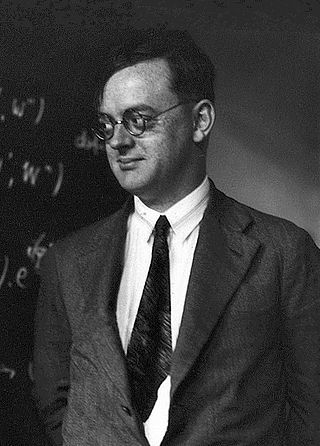Faster-than-light travel and communication are the conjectural propagation of matter or information faster than the speed of light. The special theory of relativity implies that only particles with zero rest mass may travel at the speed of light, and that nothing may travel faster.
A photon is an elementary particle that is a quantum of the electromagnetic field, including electromagnetic radiation such as light and radio waves, and the force carrier for the electromagnetic force. Photons are massless particles that always move at the speed of light when in vacuum. The photon belongs to the class of boson particles.

In cosmology, the cosmological constant, alternatively called Einstein's cosmological constant, is the constant coefficient of a term that Albert Einstein temporarily added to his field equations of general relativity. He later removed it, however much later it was revived and reinterpreted as the energy density of space, or vacuum energy, that arises in quantum mechanics. It is closely associated with the concept of dark energy.
The following is a timeline of gravitational physics and general relativity.

Zero-point energy (ZPE) is the lowest possible energy that a quantum mechanical system may have. Unlike in classical mechanics, quantum systems constantly fluctuate in their lowest energy state as described by the Heisenberg uncertainty principle. Therefore, even at absolute zero, atoms and molecules retain some vibrational motion. Apart from atoms and molecules, the empty space of the vacuum also has these properties. According to quantum field theory, the universe can be thought of not as isolated particles but continuous fluctuating fields: matter fields, whose quanta are fermions, and force fields, whose quanta are bosons. All these fields have zero-point energy. These fluctuating zero-point fields lead to a kind of reintroduction of an aether in physics since some systems can detect the existence of this energy. However, this aether cannot be thought of as a physical medium if it is to be Lorentz invariant such that there is no contradiction with Einstein's theory of special relativity.

In quantum field theory, the quantum vacuum state is the quantum state with the lowest possible energy. Generally, it contains no physical particles. The term zero-point field is sometimes used as a synonym for the vacuum state of a quantized field which is completely individual.

Annalen der Physik is one of the oldest scientific journals on physics; it has been published since 1799. The journal publishes original, peer-reviewed papers on experimental, theoretical, applied, and mathematical physics and related areas. The editor-in-chief is Stefan Hildebrandt. Prior to 2008, its ISO 4 abbreviation was Ann. Phys. (Leipzig), after 2008 it became Ann. Phys. (Berl.).

In quantum field theory, a false vacuum is a hypothetical vacuum that is relatively stable, but not in the most stable state possible. In this condition it is called metastable. It may last for a very long time in this state, but could eventually decay to the more stable one, an event known as false vacuum decay. The most common suggestion of how such a decay might happen in our universe is called bubble nucleation – if a small region of the universe by chance reached a more stable vacuum, this "bubble" would spread.

Hagen Kleinert is professor of theoretical physics at the Free University of Berlin, Germany , Honorary Doctor at the West University of Timișoara, and at the Kyrgyz-Russian Slavic University in Bishkek. He is also Honorary Member of the Russian Academy of Creative Endeavors. For his contributions to particle and solid-state physics he was awarded the Max Born Prize 2008 with Medal. His contribution to the memorial volume celebrating the 100th birthday of Lev Davidovich Landau earned him the Majorana Prize 2008 with Medal. He is married to Dr. Annemarie Kleinert since 1974 with whom he has a son Michael Kleinert.

Ernst Pascual Jordan was a German theoretical and mathematical physicist who made significant contributions to quantum mechanics and quantum field theory. He contributed much to the mathematical form of matrix mechanics, and developed canonical anticommutation relations for fermions. He introduced Jordan algebras in an effort to formalize quantum field theory; the algebras have since found numerous applications within mathematics.
The Sackur–Tetrode equation is an expression for the entropy of a monatomic ideal gas.
Stochastic electrodynamics (SED) is extends classical electrodynamics (CED) of theoretical physics by adding the hypothesis of a classical Lorentz invariant radiation field having statistical properties similar to that of the electromagnetic zero-point field (ZPF) of quantum electrodynamics (QED).
Harold Edward "Hal" Puthoff is an American physicist and parapsychologist. In the 2010s, he co-founded the UFO-dedicated company To the Stars with Tom DeLonge.
In theoretical physics, particularly fringe physics, polarizable vacuum (PV) and its associated theory refers to proposals by Harold Puthoff, Robert H. Dicke, and others to develop an analogue of general relativity to describe gravity and its relationship to electromagnetism.

The gravitational interaction of antimatter with matter or antimatter has been observed by physicists. As was the consensus among physicists previously, it was experimentally confirmed that gravity attracts both matter and antimatter at the same rate within experimental error.

Jürgen Ehlers was a German physicist who contributed to the understanding of Albert Einstein's theory of general relativity. From graduate and postgraduate work in Pascual Jordan's relativity research group at Hamburg University, he held various posts as a lecturer and, later, as a professor before joining the Max Planck Institute for Astrophysics in Munich as a director. In 1995, he became the founding director of the newly created Max Planck Institute for Gravitational Physics in Potsdam, Germany.

In cosmology, the cosmological constant problem or vacuum catastrophe is the substantial disagreement between the observed values of vacuum energy density and the much larger theoretical value of zero-point energy suggested by quantum field theory.
In quantum field theory in curved spacetime, there is a whole class of quantum states over a background de Sitter space which are invariant under all the isometries: the alpha-vacua. Among them there is a particular one whose associated Green functions verify a condition consisting to behave on the light-cone as in flat space. This state is usually called the Bunch–Davies vacuum or Euclidean vacuum, actually was first obtained by N.A. Chernikov and E. A. Tagirov, in 1968 and later by C. Schomblond and P. Spindel, in 1976, in the framework of a general discussion about invariant Green functions on de Sitter space. The Bunch–Davies vacuum can also be described as being generated by an infinite time trace from the condition that the scale of quantum fluctuations is much smaller than the Hubble scale. The state possesses no quanta at the asymptotic past infinity.

Superfluidity is the characteristic property of a fluid with zero viscosity which therefore flows without any loss of kinetic energy. When stirred, a superfluid forms vortices that continue to rotate indefinitely. Superfluidity occurs in two isotopes of helium when they are liquefied by cooling to cryogenic temperatures. It is also a property of various other exotic states of matter theorized to exist in astrophysics, high-energy physics, and theories of quantum gravity. The theory of superfluidity was developed by Soviet theoretical physicists Lev Landau and Isaak Khalatnikov.










